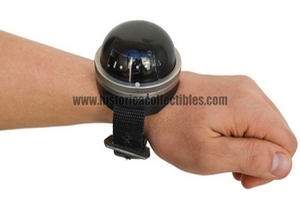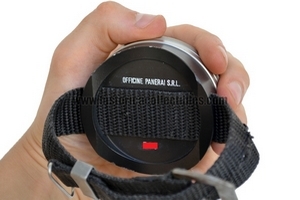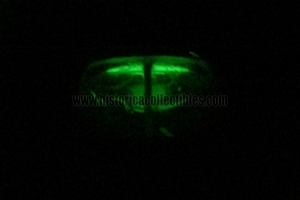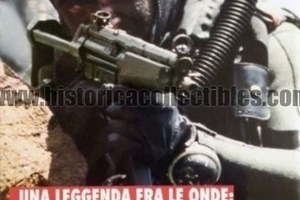Compass mod. BSP852 Officine Panerai "Comsubin" - GOI, 1977
Underwater compass Model BSP852, produced by Officine Panerai Florence in 1977, to be destined for the Comsubin (GOI - Gruppo Operativo Incursori) of the Italian Navy.
This model, derived from the previous version called BSP851, features some important improvements compared to the previous version:
- It was deemed appropriate by Panerai, under Comsubin's directives, to "cover" the dome in "Perspex" with a black "film", leaving an open window on the truncated cone wind rose exposed to view from which it is possible to read a sector equal to 45 °. In fact, on the BSP851 model, the size of both the compass rose and the luminescence of the indications made the compass dangerously visible even at a depth of 4/5 metres, jeopardizing the missions of the raiders who could easily be spotted. This initial design "defect", completely resolved in this version, was contained by the raiders by covering the dome with a piece of fabric.
- The indexes and letters indicating the cardinal points are treated with tritium and above all they are also illuminated by a self-luminescent tube inserted under the shell itself. This novelty was still a new self-luminescence patent called TRASER. This system consists of micro ampoules, containing tritium gas, placed under the compass cap. To create the TRASER, Panerai technicians took inspiration from their first famous patent: the RADIOMIR. In the 1940s there was also a mixture of radium in the ampoules.
- On this model of compass the rotating ring is no longer used but the operating principle, so called at the finish line, is the same, indeed: this compass was also used on devices such as individual drivers.
Complete with its original case.
Officine Panerai was founded in 1860 in Florence by Giovanni Panerai (1825-1897) who opened a small high-precision mechanical and watchmaking business on the Ponte delle Grazie. In the following years, with the passing of Giovanni Panerai, his nephew Guido (1873-1934), son of Leon Francesco, Giovanni's eldest son, took over the reins of the company. After several moves it moved to the "historic" headquarters par excellence in S. Giovanni Square in front of the Baptistery, in the Archbishop's Palace.
Swiss watchmaking becomes the dealer of the most important Swiss watch brands, first of all Rolex with which an exclusive and privileged relationship was created which helped to build the first Panerai watches. Guido Panerai was a man rich in inventiveness, he attended the academy of fine arts and was also a talented painter, he set up another business, the "Guido Panerai Officina Meccanica". He had 2 children: Maria and Giuseppe, with the latter in 1925 he opened Guido Panerai & Figlio with the business name of trading in precision tools and watchmaking supplies." Giuseppe was a brilliant person, a man passionate about his work, he invented and he patented the most disparate things, but the "breakthrough" invention was that of the Radiomir. It was a process for making instrument dials, sighting devices and telescope reticles self-luminous.
The process obtained by using a mixture of phosphorus and radioactive material in paste, was introduced into alveoli obtained in the material constituting the dial of the instrument or the reticle of the telescope, or into tubes of transparent material. Radiomir brought the attention of the Royal Navy to this company, which celebrated the self-luminous achievements of the MAS and the targeting systems for cannons. In the following years, the company's activities became totally conditioned by the needs of the Royal Navy.
In 1936, the first submarine group of the Royal Navy asked Officine Panerai for a wristwatch capable of facing sea diving and offering visibility in deep, unclear waters. The Radiomir watch was born. Obviously prototypes were prepared, with a dial with bar indexes and dots with various types of dial including a Rolex California dial-inspired dial, i.e. the upper half with Roman numerals and the lower half with Arabic numerals.
Then, with the dial with Arabic numerals at the cardinal points and bar indices, in one of the first prototypes with a composite bakelite dial, fixed to the brass back by 2 rivets in the center of the dial itself.
In 1938 the first supplies to the Royal Navy began. The dial was a sandwich or also known as the Paris model (name of its inventor), i.e. composed of two parts, the lower part was a "little box" which contained the radium mixture (contained by a veil of plexiglass) and the upper part with the perforated numbers and indexes. The case is 47mm cushion-shaped steel, with wire-welded lugs, screw-down crown engraved with the Rolex crown.
The custom forge screw-down caseback opens via a special faceted key supplied by Rolex. Inside the case back the Rolex hallmarks, serial and reference numbers.
The glass is a kind of plexi, called Perspex about 4 mm thick. These watches were on the wrists, during the Second World War, of the Sailors of the assault vehicles of the to his second Emilio Bianchi, one of the 3 pairs of stormtroopers of the 2 flagships of the English fleet in the Mediterranean. They were on the pulse of the MOVM Luigi Ferraro while alone in the spring of 1943 he sank 4 ships off the port of Alessandretta (Turkey). They were on the wrist of Licio Visentini, another Gold Medalist of the
They were also awarded to soldiers of other nations, the German Kampfschwimmers of the Kriegsmarine, who trained with the Gammas of the Xth MAS Flotilla during the RSI period in Italy. These watches had no wording on the dial, anonymous, but certainly made by Panerai.
All the straps mounted on the Panerai were in die-cut leather and long in size to be worn over the wetsuit, with an appropriately sized pin buckle. In addition to watches, Panerai supplies other wrist items such as compasses and depth gauges with various scales for different uses, these objects had a diameter of approximately 70 mm, and are now highly sought after by collectors.
During the conflict, the "G. Panerai & Figlio mechanical workshops" intensified their projects for the Royal Navy, some marketed or rather sold to the Navy itself and others remained in prototype status, this is the case of the Mare Nostrum chronograph. Watch made in a couple of examples intended for Navy Officers, it will only be marketed in the distant future.
Also during the conflict, the Radiomir project was especially evolved, the experience and prolonged use in hostile environments highlighted where to intervene to improve: first of all the wire lugs were abandoned as they tended to unsolder, bend and even tear.
Sometimes, however, prolonged use of the crown wore out its sealing gasket and did not guarantee the waterproofness necessary for the watch to flood. This inconvenience was resolved with a patent which today is the Panerai trademark, namely the bridge crown protector: a steel crescent with an eccentric lever that always tightens the crown to the same position. Simple but effective patent, its design makes the watch unmistakable (the watertightness of the watch is 20 atm equal to 200 m). This device was only patented in the second half of the 1950s, but its use had already been in place for over a decade.
After the war, the collaboration between Panerai and the newly formed Italian Navy continued. New supplies were requested to be entrusted to their special departments, as well as watches, compasses, depth gauges, torches and knives, including the Galeazzi knife built to the specifications of the newborn Comsubin.
However, a distinctive element of Panerai watches could no longer be used because it was considered harmful, Radiomir, so a tritium-based mixture called LUMINOR was studied and also replaced the wording on the dials themselves.






